

Injection molding is an extremely popular manufacturing technique that is employed by various industries to mass-manufacture an array of products. A key aspect of a successful injection molding process is an apt mold. The mold should demonstrate durability and accuracy to produce parts of consistent quality. If the mold design is inaccurate or inconsistent, it can compromise the quality of the parts.
Mold flow analysis is a software technology that has revolutionized the mold design aspect of injection molding. In this article, we discuss mold flow analysis, its various advantages, and how it supports DFM in producing high-quality plastic parts.
Mold flow analysis software demonstrates the flow of molten resin throughout the injection molding cycle. It is a software-based simulation that predicts how molten resin flows into and fills an injection mold. This analysis is carried out before the injection molding process.
Mold flow analysis enables manufacturers to optimize mold designs and build molds that create parts of the highest quality. It also helps engineers avoid injection molding defects by making informed decisions early on in the design phase.
Mold flow analysis helps to maximize resources by improving the entire injection molding process.
Mold flow analysis should be conducted before the tooling process. The mold flow analysis software predicts how the part is filled during molding which further streamlines and optimizes the process before tool manufacturing. Conducting a moldflow simulation at this stage enables engineers to identify any type of technical errors before the investment of various resources such as time, money, and materials.
You should note that mold flow analysis isn’t required for every application. To decide whether it’s required for your application, there are certain factors that can help you decide the same. Let’s understand these factors further:
If the mold is particularly simple, then a moldflow simulation isn’t necessary and it’s easier to predict how a simple mold will operate, thus it may be unnecessary to conduct a moldflow simulation in such cases. If however; the part design is complex, then the flow isn’t very predictable. In such cases, mold flow analysis is extremely beneficial.
It is imperative to understand the materials when deciding to perform the mold flow analysis.
When standard materials are employed, the fill patterns are more predictable. However; if non-typical materials, especially with fillers are employed, then the fill patterns can be unpredictable. You should also note that it is significantly harder to predict how the material will fill the mold when the material characterization is unavailable. In such cases, a mold flow simulation is recommended.
The next factor that should be considered is tolerance requirements. If tight tolerances are required, then mold flow analysis can be extremely beneficial. It can analyze whether the part will meet the specific requirements before tool cutting.
There are various types of mold flow analysis software solutions. In this section, we enlist some of the most popular and best mold flow analysis software solutions:
Autodesk Mold Flow is one of the most widely employed mold flow analysis software solutions. This software solution has two main versions: Mold Flow Adviser, which is available in Premium and Ultimate versions, and Mold Flow Insight, which is available in Standard and Premium versions.
Autodesk is a CAD-based software that creates part designs and simulations to predict the outcome of the finished product. It’s comparatively easy to use and has an intuitive interface. You can read more about autodesk mold flow here.
Moldex3D is also one of the best mold flow analysis software solutions and has two versions; Moldex eDesign and Moldex Solid.
Moldex3D is straightforward, easy to use, and extremely intuitive. It’s compatible with various computer programs. You can read more about Moldex 3D here.
Sigma enables manufacturers to simulate the entire product and is thus, one of the best mold flow analysis software solutions for simulating from start to end. Sigma also has an inbuilt tracer that is ideal for weld lines and demonstrates excellent accuracy. You can read more about Sigma Soft Virtual Molding software here.
Solidworks Plastics is an add-in mold flow simulation software of the Solidworks CAD package. It’s available in three formats:
You can read more about Solidworks Plastics software solutions here.
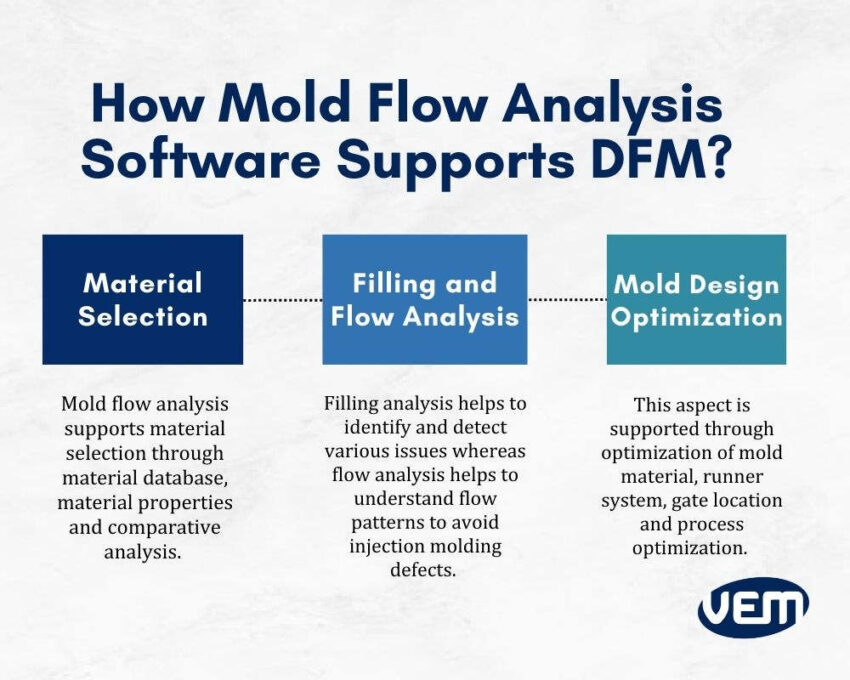
Mold flow analysis software supports DFM, abbreviated for design for manufacturability in the following areas:
Mold flow analysis software makes it possible to analyze the flow of various resins during the injection molding process. This information is extremely beneficial, thus, enabling engineers to incorporate the best plastic material for the injection molded parts. The key aspects of mold flow analysis in material selection are described below:
Mold flow software encompasses a database of various resins with specific properties, such as rheological, thermal, and other flow-related characteristics. This database includes regular resins as well as commodity plastics, specialty plastics, and polymer blends.
Mold flow software with material analysis capabilities enables you to choose materials based on specific properties. The mold flow analysis software further makes use of this information to simulate the behavior of resins at each stage of the injection molding process.
Some mold flow analysis software can simulate multiple materials so that comparable results are available side-by-side. This helps engineers to make informed decisions.
A filling analysis helps manufacturers identify and detect various issues such as air entrapment or uneven filling by determining how the molten resin will fill the mold cavity. This information can be employed to modify the tool’s design to ensure that the mold cavity fills without any shortage.
Flow analysis enables manufacturers to understand flow patterns which in turn helps to avoid an array of injection molding defects.
Mold flow analysis simulation demonstrates heat transfer during the injection molding process. You should note that different plastic materials melt at distinct temperatures and it is thus imperative to understand how the mold’s thermal performance affects plastic parts. Excessive heat can cause the resins to degrade. In addition, if the mold temperatures are high, the resin might stick to the mold and if the mold temperatures are extremely low, then injection molding defects such as sink marks can occur.
Mold flow analysis helps to determine the apt runner system to transfer molten resin to the mold’s cavity. It can help to analyze the size, shape, type, and various other details thereby, enabling further optimization of mold design.
Gates enable the molten resin to enter the mold cavity. Moldflow simulation analyzes various gate locations and can suggest the best possible gate locations so that the mold fills evenly and completely.
In addition to the optimization of mold design, Mold flow analysis also helps manufacturers to optimize processes. Injection molders can adjust the injection pressure, holding pressure, melt temperature, and various other parameters by taking into consideration the data from mold flow analysis.
Mold flow analysis examines the design of the mold and creates color maps that indicate the various properties in the actual mold flow. These properties represent various aspects such as the injection pressure, air bubbles, weld lines, heating, cooling, etc.
The color maps enable the engineers to change the part design to ensure quality before the molding process begins. The following video demonstrates mold flow analysis:
A mold flow analysis examines how the molten plastic will flow through the mold and the above simulation demonstrates how the mold will perform. It helps to understand various aspects of the mold design such as the shrinkage factor, warpage, weld lines, processing conditions, etc.
Let’s understand the specific steps of the mold flow analysis process:
The process of mold flow analysis starts by creating a digital model of the part and mold in the software. This digital model can either be built directly in Moldflow software or imported from the CAD software.
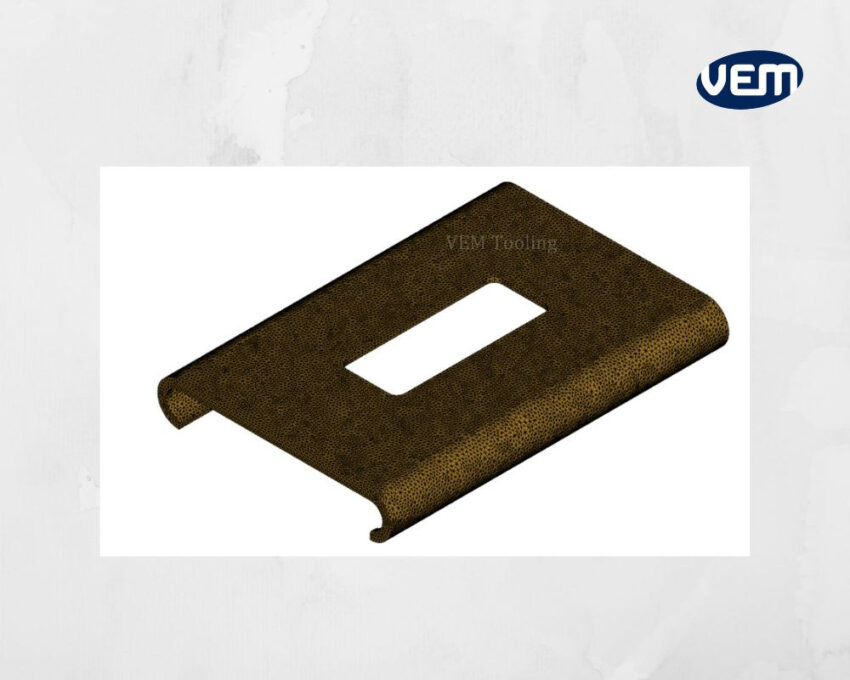
The next step in moldflow simulation is to create the mesh. In this step, the part is divided into a mesh of smaller elements to create a detailed and finite element model which helps in accurate simulation. The mesh created in this stage defines how the material will flow, cool, and solidify.
In this step, engineers specify the material being employed. Various details such as the type of plastic, its properties, viscosity, etc. are entered to understand so that the moldflow analysis software can simulate how the material will behave under specific conditions.
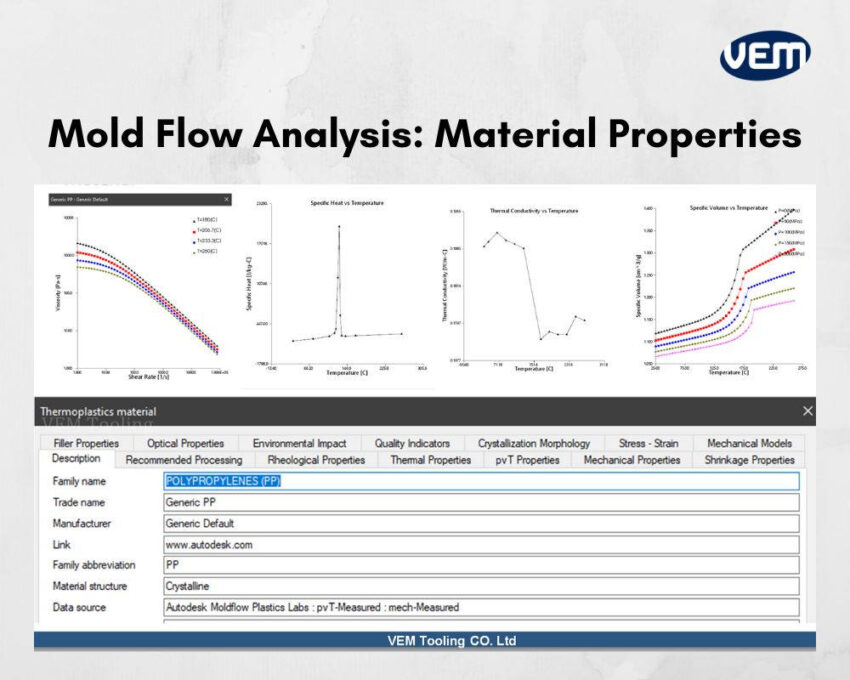
In the flow simulation step, the mold flow analysis software simulates the injection of molten plastic into the mold. It helps engineers analyze how the material will flow into the mold cavity and helps to identify various concerns such as uneven filling, weld lines, short shots, etc.
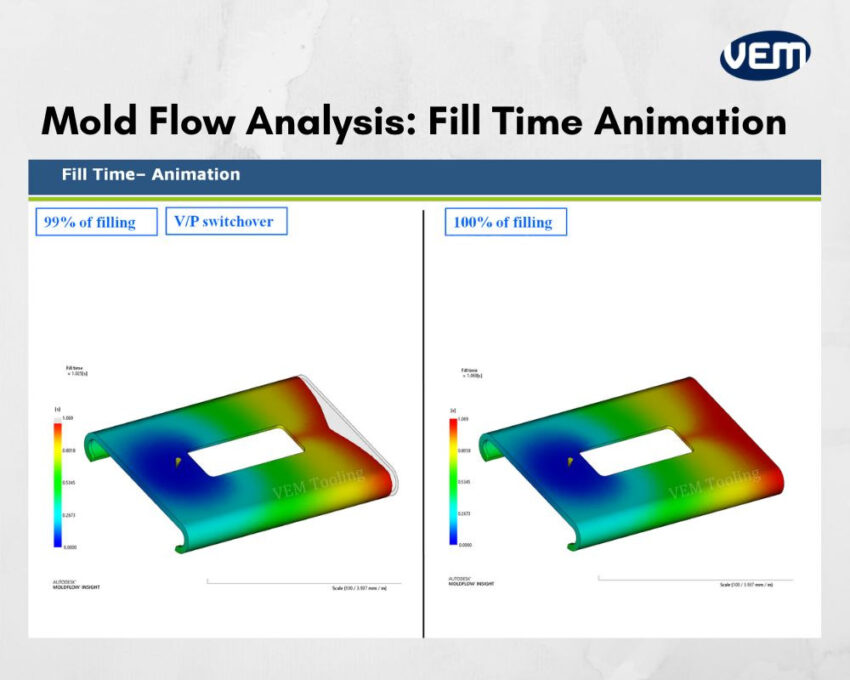
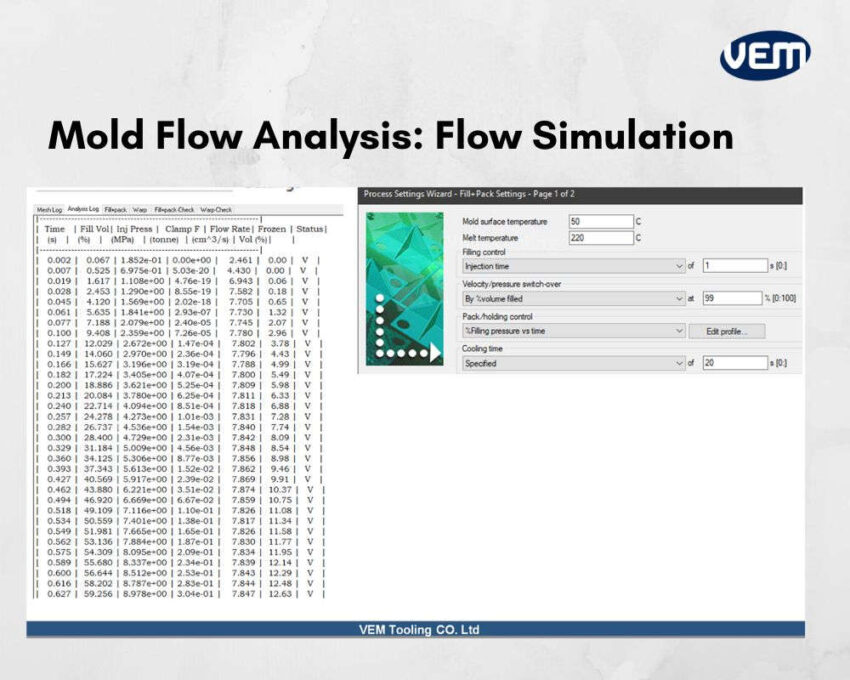
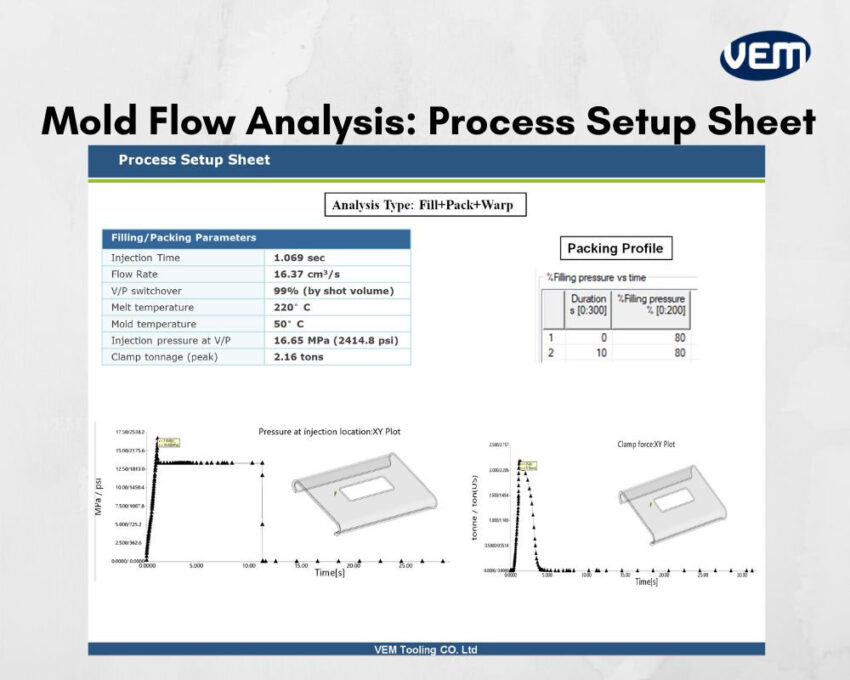
In the cooling analysis step, the moldflow analysis simulates the cooling process as the part solidifies. This step helps to detect issues such as warping, sink marks, or internal stresses that could affect part quality.
The optimization step provides insights to improve the molding process. It provides suggestions such as how to adjust the mold design, injection parameters, and cooling systems. For instance: The software can suggest changes to the placement of injection molding gates, mold temperature, or pressure settings to ensure optimal flow and cooling.
Mold flow analysis provides detailed visual results of flow patterns, temperature distribution, and potential defects.
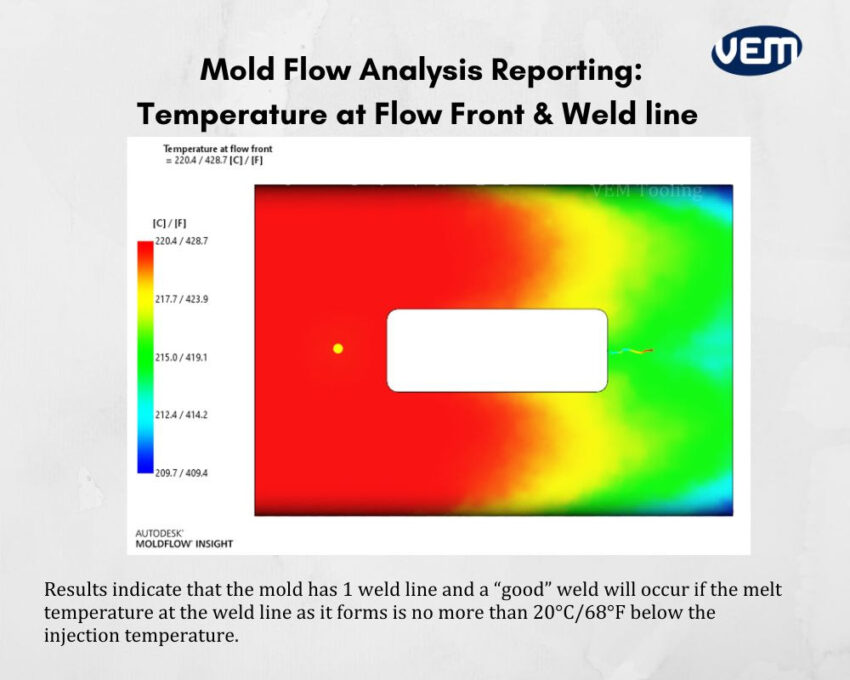
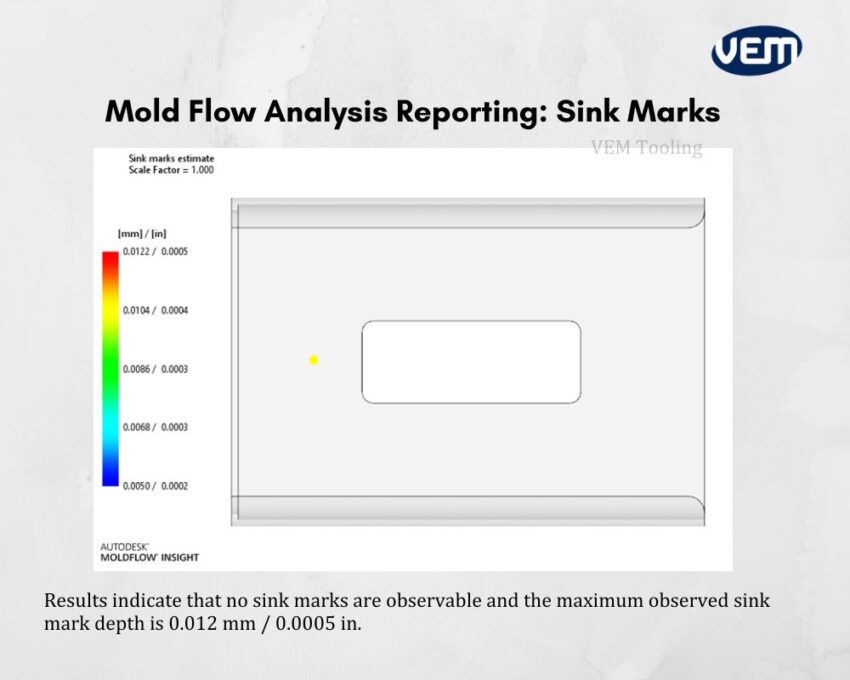
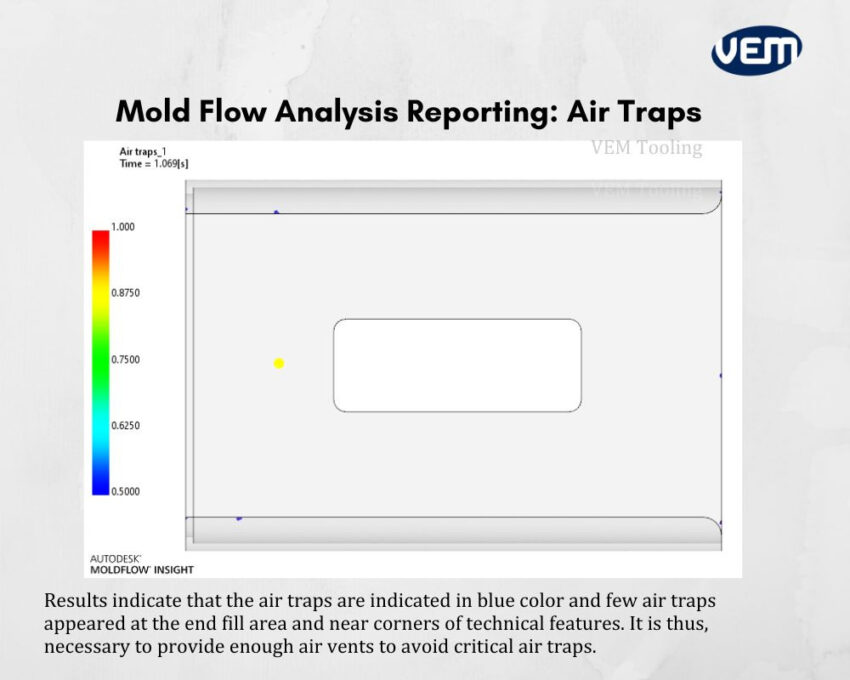
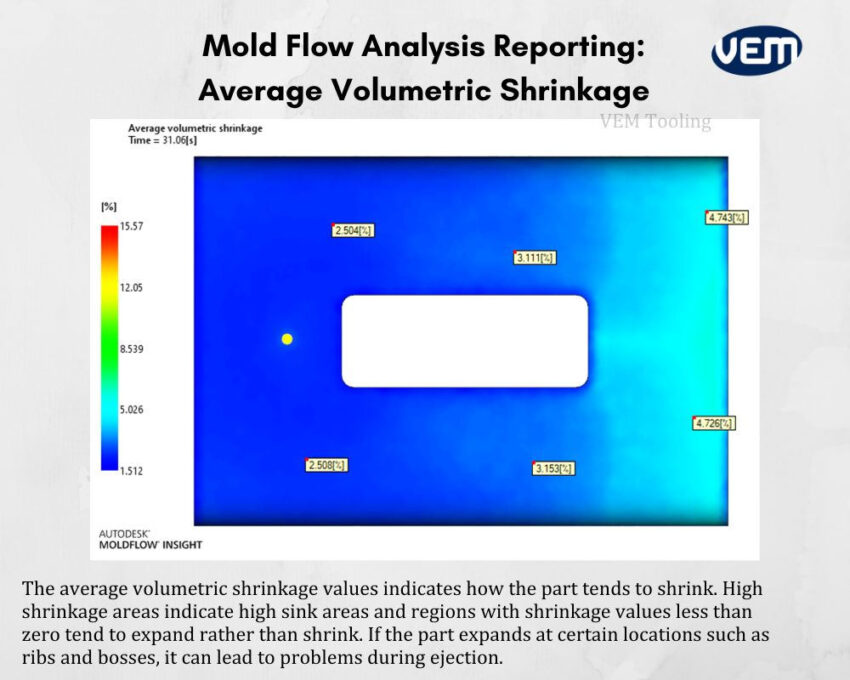
You can use the results of the mold flow analysis to make design adjustments and test different case scenarios to further optimize the molding process. These results help with identifying flow issues, temperature distribution, air traps and venting, warping and shrinkage, material selection and behavior, weld lines and surface defects, cycle time optimization, simulation of multiple scenarios, and cost reduction
In summary, Moldflow analysis results provide critical insights that can be incorporated to improve part design, reduce manufacturing issues, optimize production efficiency, and enhance overall product quality. This further leads to lower costs, faster time-to-market, and reliable final parts.
Mold flow analysis offers several advantages to tool design. Let’s understand the various benefits of incorporating the mold flow analysis software:
Mold flow analysis enables early identification of specific design issues thus, enabling design optimization. It helps to identify the most crucial and necessary aspects of the production process.
Mold flow analysis identifies and reduces errors in the mold design process. In addition, you can also incorporate design improvements thereby, enabling new design adjustments. These latest design adjustments further help to improve product quality.
Gate positions are an integral and crucial aspect of any injection molding process as they allow the molten resin to enter the mold. If the gate positioning is incorrect, it can lead to incomplete mold filling, leading to unevenly filled parts due to uneven distribution.
Mold flow analysis simulation makes it possible to optimize gate positioning by determining the correct position for each gate in the mold, thus making it possible to fill the mold evenly.
One of the major advantages of mold flow analysis software solutions is that it can help to identify and predict fill patterns which further enables engineers to simulate molten resin flow in a mold. Thus, mold flow analysis enables redesigning more effective molds through fill pattern prediction.
Parts with different wall thicknesses can lead to warping due to pressure. Such issues can be identified and avoided using mold flow analysis.
Mold flow analysis ensures uniform filling of mold cavities thus, minimizing the possibility of air traps and surface defects such as sink marks and weld lines.
In injection molding, there are an array of materials to choose from. Mold flow analysis makes it possible to compare the various physical and chemical attributes of materials before production.
Moldflow simulation makes it possible to understand various materials quickly. It thus enables manufacturers to select a material that’s apt for the part and its intended purpose.
The plastic material that is employed for manufacturing parts typically undergoes temperature changes as it is subjected to extreme temperatures of intense heat and fast cooling. Thus, most parts shrink in the cooling phase which is why it is crucial to understand and account for the shrinkage rate of the material.
Mold flow analysis helps engineers to determine the shrinkage rate for the material thus, enabling them to choose the correct material for their application.
Design errors can lead to defects in parts which can be extremely expensive to correct. Mold flow analysis makes it possible to identify these defects early on and they can thus be avoided.
Lead time is the time taken for the product to be available for distribution and it should be as low as possible! Various factors influence an increment in lead time. Moldflow simulation software enables the identification and analysis of these factors and thus, helps to reduce the lead time.
Mold flow analysis enables the optimization of various parameters of the process such as materials, tools, machine specifications, cooling, and cycle times. Thus, Moldflow simulation software solutions can create a very streamlined and seamless operation.
Moldflow analysis simulation is an extremely beneficial process for optimizing mold designs.
VEM Tooling has over 20 years of experience in building durable molds and manufacturing high-quality parts. Our experienced engineers and quality specialists can guide you throughout the mold flow analysis process and other injection molding solutions.